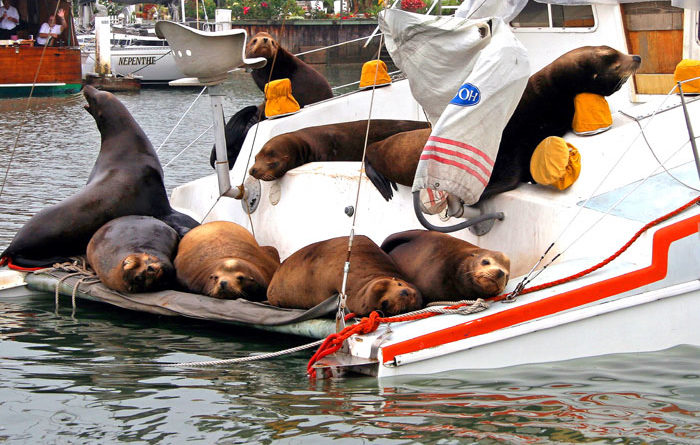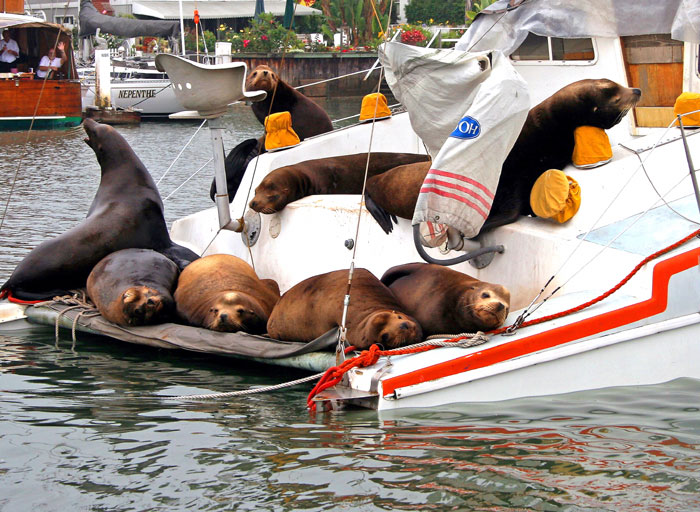Boaters Seeing Fewer Sea Lions on Boats and Docks
Byline: Shane Scott
NEWPORT BEACH — When boaters catch sea lions hanging around their docks in large numbers, most see a nuisance situation. Marine biologists, on the other hand, see a bigger problem.
They wonder, “Why are these animals sitting in Newport Harbor or Marina del Rey, instead of being out on an island where there aren’t any humans?” said Keith Matassa, executive director of the Laguna Beach-based Pacific Marine Mammal Center (PMMC). His organization is often involved in sea lion rescues and has been closely watching the animals — paying particular attention to the unusual mortality rate that sea lions experienced this year.
“We’ve had about 370 rescues this year, 167 (of which we treated) in house,” Matassa said. “Usually, we have maybe 180 rescues; 40 in house at the same time.”
This trend toward increased sea lion injuries and deaths started last December — “and it just kept going; and it finally started to slow down in July,” Matassa said.
When a Newport Harbor boater sees a sea lion, his or her immediate response is probably to encourage the animal to get off the dock, boat, dinghy or whatever other private boat area they are occupying. In fact, in Newport Harbor, it’s part of boat slip and dock users’ contractual obligation.
“We do enforce, if there’s a problem boat that’s a recurring problem not being solved by the boat or dock owner,” Newport Harbor Resources Manager Chris Miller said. “We basically put that permitee on notice that they need to do something quick.”
Permitees have seven days after receiving a notice from the city to discourage the sea lions. “Once it was 30 days, but that was too long: Sea lions would just keep people up for 30 days,” Miller said.
When too many sea lions gather in one place, it can get loud and smelly, and there can be expensive damage. They make a lot of noise; they compete for space, often barking at one another; they can jump very far out of the water; they can damage swimsteps; and they leave behind a dark oily substance that is hard to get out of your boat’s gelcoat, Miller noted.
“They’ve been known to sink a few boats in years past, (but) these were mostly derelict boats,” Miller added,
If sea lion troubles get too severe, the city brings in the big guns — hiring contract workers to spray the mammals away with water cannons.
“A few years ago, we were going out on the order of 30 to 45 nights a season,” Miller said. “Generally, in those years, we would be going out in August, September and October. This year and last year, we haven’t had to go out at all — so they’re better guests this year.
“I don’t know if I’m qualified to say there’s been a decrease in the population” of sea lions in the harbor, Miller said, “but logically, one would assume there might be, because we haven’t been seeing them.”
Indeed, many sea lion pups did not survive this year.
“One year of losing that many pups probably won’t affect the sea lion population, but multiple times (years of high pup mortality rates) will,” Matassa said.
It isn’t just sea lions that have been dying. Matassa has witnessed an increase in the number of unusual mortality events for a lot of animals.
The National Oceanic and Atmospheric Administration’s website shows that in the last five years, there have been unusual mortality events for walrus, sea lions, cetaceans, pinnipeds, large whales and harbor porpoises on the West Coast. “That tells me something’s going on with the environment,” Matassa said. “How that’s going to affect these (local) animals? We don’t know.”
Where they lack answers, the PMMC will be holding active surveys, going out on boats to find tagged sea lions, to conduct regular analysis within Orange County waters.
“We’ve re-sighted animals that have been in our rehab center six to seven years ago,” Matassa said. “We want to know how are animals are doing after rehab.
“We’re going to go out on a boat and look for our tagged animals — during the summer, winter and fall — and find out how many animals out there are entangled, and how many have flipper tags,” he said.
Along with its own active surveys, PMMC is developing a website where they and other organizations can add data about surrounding mammals.
“We’re going to use satellites to follow tagged animals — how far they’re diving, duration of dives and things of that nature,” Matassa noted. The website, tentatively called West Coast Marine Animal Identification, which will be mirrored off Woods Hole Oceanographic Institution’s Marine Animal Identification Network, will work hand in hand with another program that PMMC is developing: the Citizens for Science program.
“We’re going to go out and educate; hand out brochures; talk to specialized groups, like paddleboarders, boat shops, anybody who uses the water; and we’re going to teach them how to photograph and chart tagged animals,” Matassa explained. Citizens will be able to use the animal identification website to upload photos, share statistics on animals they have spotted, and note the location where they were found.
While the PMMC appreciates boaters’ help in spotting and noting locations of tagged sea lions, Matassa warned water users to use caution around the marine mammals. “People have to realize that these are wild animals. They do bite, and they’re quick — they’re catching fish with just their mouth,” he said.
Matassa said he hopes to start the programs in early 2014 — and PMMC is currently waiting for permits to go out and do active surveys.
“The sooner we can understand what’s happening with these animals, the better for us,” Matassa said. “We need to understand that these animals are giving us a great example of what’s happening in the environment, because they are very high on the food chain.”



